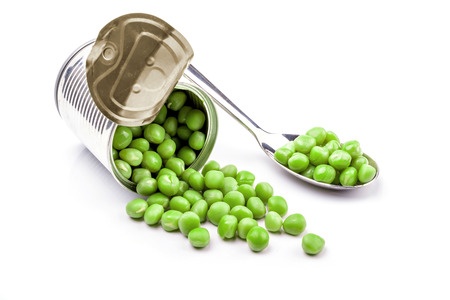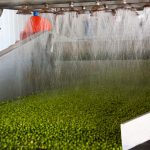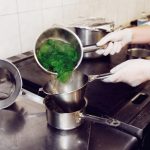
Canned vegetables are probably one of those grocery goods which always seem second best to raw, fresh produce. Nowadays, we are doing more home preservation including canning to try and keep what produce we’ve grown in the garden for much longer. If however you simply cannot get hold of fresh produce readily there is nothing better than a tin of it, especially if it’s your own home grown food or simply because it’s convenient and might just fill a hole in that recipe.
It’s all about food service and convenience.
When the processor is examining a canning option, the main feature to consider is what quality of vegetable will be achieved once it’s been processed. Can I get the desired colour and texture, retain those key nutrients which will let me make claims and help me believe my canned vegetable is as close to the freshly cooked vegetable as possible? The final consideration has to be the safety of that food in the canning. Even when you consider quality, the processing conditions will be dictated by how safe that food needs to be.
Incidentally, whilst safety is not the main feature of this item I would be mistrustful of some of the canning methods being recommended. One research group from North Dakota State University were very suspicious of how safe the methods were when they were examining home canning of green beans (Kuchynski et al., 2013).
Additives Used In Canned Vegetables
Irrespective of processing, a number of additives have been tried and tested to improve both colour and texture of the canned vegetables. Adding calcium is one way of retaining firmness and there are a variety of beans for example that have benefitted from this. Otherwise, a mushy, soft bean is the result. Calcium binds to pectin and pectate and helps the bean retain some integrity during the heating process. We’ve seen calcium added to mung bean sprouts (Buescher & Chang, 1983), pinto beans (Wang et al., 1988), navy beans (Wang & Chang, 1988; Wang et al., 1988) and edame or soy bean. The latter bean is perhaps one of the most difficult to process.
Another approach to improving firmness is to lower the pH of the brining solution which is acidification by any other name. This approach works well with southern crowder peas (Flora, 1980), mung bean sprouts and asparagus (McGlynn et al., 1993). Various food grade acids including hydrochloric, sulphuric, citric, ascorbic, phosphoric and gluconic acid have all been applied at one time or another. When you check the ingredient label you will notice which acid (acidulant) has been the one of choice.
The main issues with acidification are usually a loss of colour. A study of colour stability of canned crowder peas and asparagus, in an acidified environment, demonstrated substantial losses of colour. These became less green and more yellow after processing as the chlorophylls which make up the pigments gradually broke down with heating.
Enzyme Activity
The other quality parameter requiring attention is enzyme activity. Hence, blanching is the process of choice here to suppress any enzyme activity (Sheu & Chen, 1991). Blanching is a short time high temperature process (5 minutes; 100 Centigrade in most home cases). If any enzymes are still present they will slowly degrade both cell walls to soften the vegetable, cause colour loss and produce off-flavours. Objectionable, undesirable flavours easily turn anybody off consuming a canned product. The leading culprit are the lipoxygenases which catalyse the formation of lipid hydroperoxides producing rancid flavours, interactions with proteins in Maillard-type reactions, cross-link with proteins and decrease the nutritional value of essential fatty acids and vitamins.
Trypsin inhibitors appear to work well in suppressing activity. The inactivation time of the soybean trypsin inhibitor is significantly longer than that of the lipoxygenase (Savage et al., 1995). Going back to the Kuchynski abstract (2013) they found steam canning was the best home based method for preserving the quality of their green beans. Steam canning relied on a 30 minute cook at 100 Centigrade with rapid cooling (unspecified).
References
Buescher, R.W. & Chang, J.S. (1983). Quality improvement of canned mung bean (Vigna radiata) sprouts. Journal of Food Science, 48, pp. 1598–1603
Eriksson, C.E. (1982). Lipid oxidation catalysts and inhibitors in raw materials and processed foods. Food Chemistry, 9, pp. 3–19.
Flora, L.F. (1980). Effects of modified processing procedures on quality of southern crowder peas. Journal of Food Science, 45, pp. 126–128
Islam, M.N. & Lea, R.A. (1979). Effect of maturity on the nutrient content and the canning quality of emerald soybean. Journal of Food Science, 44, pp. 204–212
Kuchynski, J., Hall, C., Gibbs, P., Garden-Robinson, J. (2013) 302-32 Assessing Microbial Stability and Quality of Green Beans Using Various Home Canning Methods. 2013 IFT Annual Meeting, July 13 – 16, 2013, Chicago Illinois
McGlynn, W.G., Davis, D.R. & Honarmand, F. (1993). Gluconic acid influences texture and colour of canned asparagus. Journal of Food Science, 58, pp. 614–615
Savage, W.D., Wei, L.S., Sutherland, J.W. & Schmidt, S.J. (1995). Biologically active components inactivation and protein insolubilization during heat processing of soybean. Journal of Food Science, 60, pp. 164–180
Sheu, S.C. & Chen, A.O. (1991). Lipoxygenase as blanching index for frozen vegetable soybeans. Journal of Food Science, 56, pp. 448–451.
Wang, C.R. & Chang, S.K.C. (1988). Effect of selected canning methods on trypsin inhibitor activity, sterilization value, and firmness of canned navy beans. Journal of Agriculture and Food Chemistry, 36, pp. 1015–1018
Wang, C.R., Chang, K.C. & Grafton, K. (1988). Canning quality evaluation of pinto and navy beans. Journal of Food Science, 53, pp. 772–776.



Leave a Reply